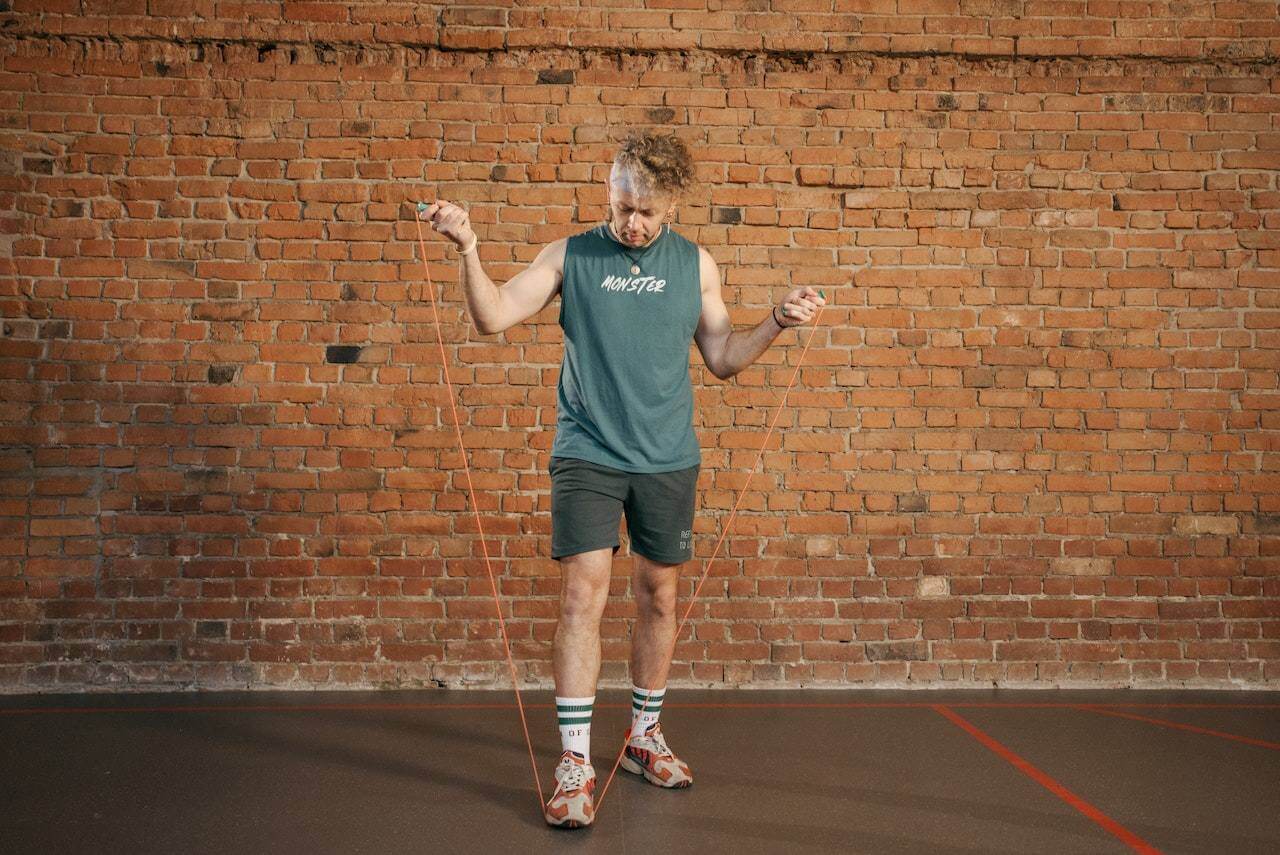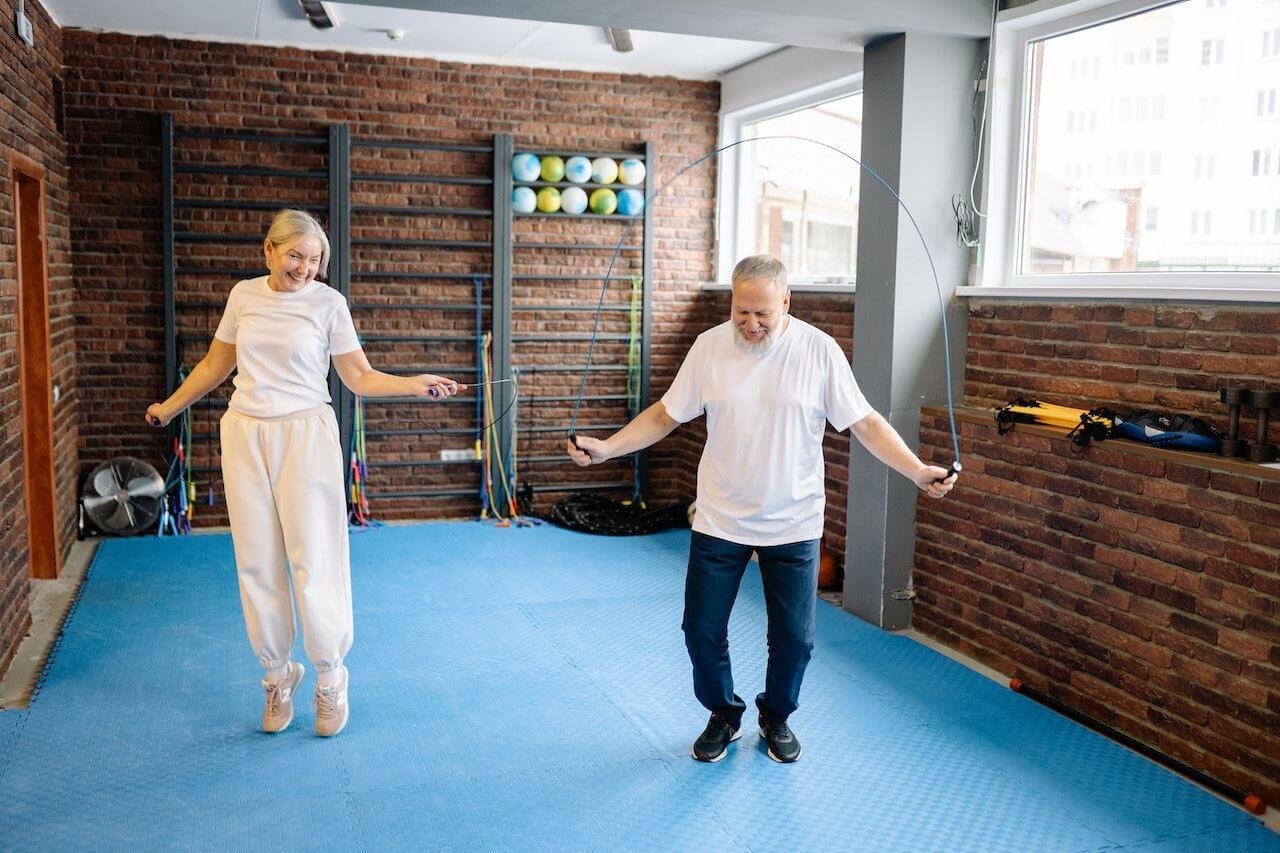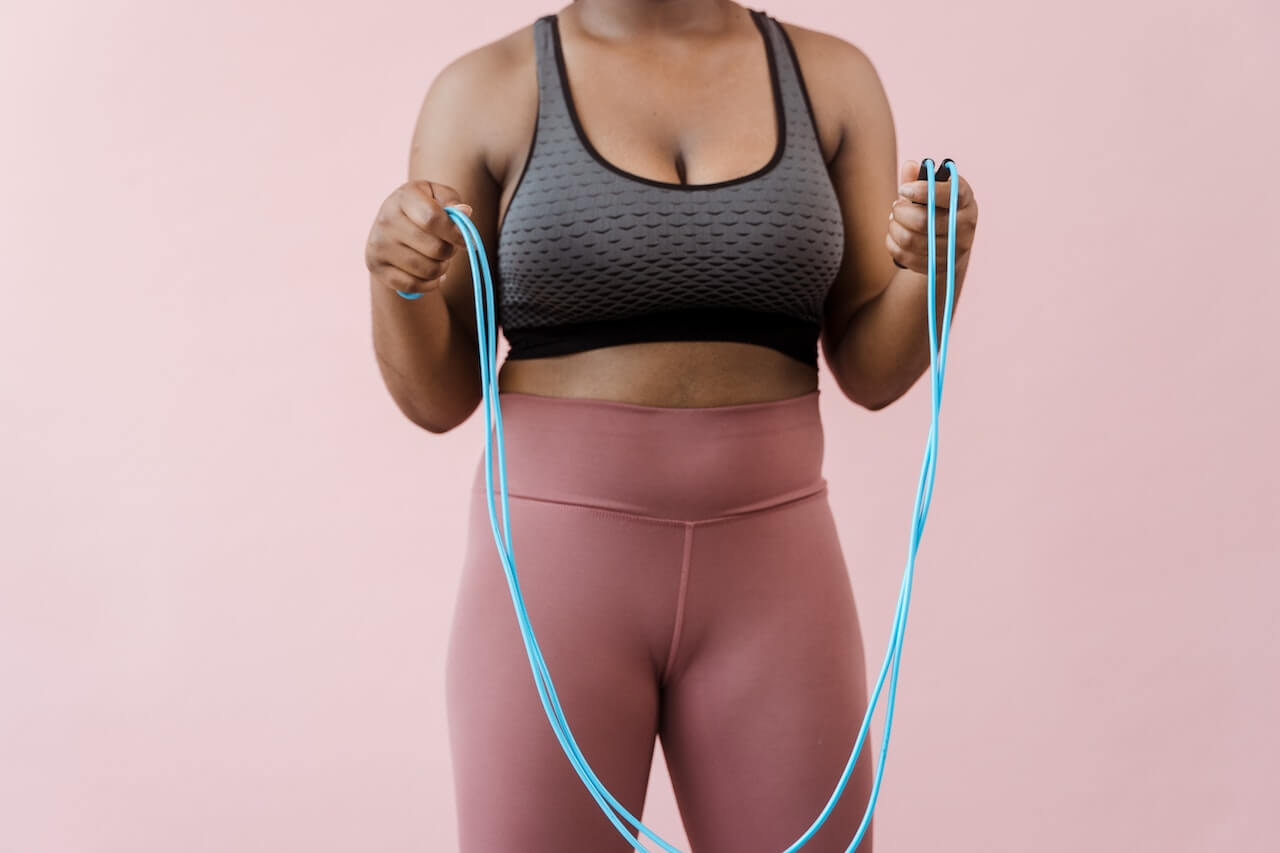When it comes to effective and efficient workouts, jump roping (or skipping rope) has become a popular choice of high-intensity cardio training among personal trainers and fitness enthusiasts. This classic childhood activity holds incredible potential to enhance your fitness levels and achieve your weight loss goals while providing a fun and enjoyable workout experience.
In this blog post, we'll dive into the numerous health benefits of jump roping and provide some useful tips to help you improve your skills and maximize your weight loss potential.
What is Jump Roping?
Jump roping is a rhythmic exercise that involves jumping over a rope that you are swinging over your head and under your feet using a handle in each hand. It is a simple yet highly effective form of cardiovascular exercise that has been practiced for centuries. Jump roping can be performed individually or in groups, as a warm up or main fitness activity, and is suitable for people of all ages and fitness levels.
The rope is swung over the head and under the feet, requiring coordination, balance, proper form, and timing to maintain a steady rhythm. This dynamic activity offers an intense, sweaty workout while evoking a sense of nostalgia, reminding many adults of their childhood playtimes. Whether you're a beginner, a seasoned fitness enthusiast, or a high-level athlete, jump roping provides an accessible and enjoyable way to improve your health, fitness, and athletic performance.
{{mid-cta}}
What Does Jumping Rope Do? Here are 11 Health Benefits
By incorporating jump roping into your fitness routine and gradually honing your skills, you can unlock a world of fitness advantages while enjoying a nostalgic and energizing workout. Let's explore the incredible health benefits that jump roping brings to the table.
- Improved cardiovascular fitness: Regular jump roping sessions can strengthen your heart and lungs, improving your overall cardiovascular fitness. This activity increases heart rate, improving blood circulation and muscle oxygen delivery. Over time, this can lead to increased stamina, endurance, and improved cardiovascular health.1
- Increased calorie burning: Jump roping is proven to burn calories quickly. Research has found it to be at an intensity of 11.8 METs, meaning it has the potential to burn around 15 calories per minute, depending on your weight.4
- Enhanced coordination and agility: Jump roping requires coordination between your hands, feet, and eyes. Your brain and muscles work together to maintain rhythm and timing as you jump and rotate the rope. Over time, this improves your hand-eye coordination, agility, and overall motor skills.
- Strengthened muscles: Jump roping engages multiple muscle groups in your legs, core, arms, and shoulders. Specifically, the constant jumping motion targets your lower body muscles, including the calves, quadriceps, hamstrings, and glutes.
- Improved bone density: Many studies and meta-analyses find weight-bearing physical activities, such as jump roping, have a greater impact on bone mineral density than non-weight-bearing activities, which can reduce the risk or development of osteoporosis.2,3
- Improved mental focus and cognitive function: Jump roping requires coordination, rhythm, and timing, which engages the parts of your brain involved with high motor skills and coordination. Research shows regular sessions can enhance your attention, concentration, and cognitive function.5
- Enhanced endurance and stamina: Studies have found a positive impact on markers of endurance and stamina, such as VO2 max, in individuals who jump rope at an intensity of at least 100 jumps/min.1
- Increased lymphatic system function: Jumping rope activates the lymphatic system, which is crucial in removing toxins and waste products from your body. The rhythmic movements help facilitate lymphatic drainage, improving circulation and immune system function.6
- Improved cardiovascular health markers: Engaging in this high-intensity exercise stimulates the cardiovascular system, leading to stronger heart health, improved blood flow, and increased cardiovascular efficiency. It can also help lower blood pressure, reduce LDL (bad) cholesterol levels, and improve insulin sensitivity when paired with a healthy diet.7,11
- Enhanced respiratory function: The increased breathing rate while jump roping strengthens the muscles involved in respiration and improves lung capacity. As a result, your body becomes more efficient at oxygen uptake and carbon dioxide removal, enhancing your overall respiratory health.8
- Improves energy levels: regular physical activity such as jump roping has been proven to help increase energy levels by up to 65%.12

Jumping Rope vs. Running
Jump roping and running are both excellent forms of high-intensity cardiovascular exercise, but they have distinct differences that make each option unique. Let's compare jump roping and running to see which is better for you.
- Calorie burning: Jump roping and running are both effective calorie-burning exercises; however, jump roping tends to have a slight edge in calorie expenditure. Jumping rope at a moderate intensity can burn approximately 14 to 16 calories per minute, whereas running at a moderate pace burns roughly 8 to 12 calories per minute. This means that jump roping can offer a more efficient calorie-burning workout in a shorter amount of time.4
- Impact on joints: One significant advantage of a jump rope workout over running is the reduced impact on joints. The repetitive impact of running can stress the knees, ankles, and hips, increasing the risk of joint injuries and discomfort. On the other hand, jump roping has been found to have lower impact forces on the joints compared to running due to the cushioning effect.9 Lower-impact activities are a great option for individuals with joint sensitivities or previous injuries.
- Cardiovascular benefits: Both activities provide excellent cardiovascular benefits. Some research has found jumping rope to provide greater improvements in cardiovascular fitness as participants achieved higher heart rates while jump roping when compared to running at various speeds up to 5.5mph.10
- Convenience and accessibility: Jump roping requires minimal space and equipment and can be done indoors or outdoors. It is a portable exercise that you can easily incorporate into your routine, making it suitable for those with limited space or access to a gym. On the other hand, running requires a larger space, such as a track, trail, or sidewalk. While it can be done outdoors and is accessible to many, it may be less convenient in inclement weather conditions or for those with limited access to safe running areas.
Is Jumping Rope Good for Weight Loss?
Jump roping is a fantastic exercise for weight loss due to its combination of high intensity and calorie-burning potential and its effects on reducing insulin sensitivity.11 It engages multiple muscle groups making it a full-body workout that increases muscular strength and cardiovascular fitness. Your heart rate and metabolism increase with continued sessions, resulting in efficient calorie burning during activity and rest. As mentioned, jump roping can burn approximately 200 to 300 calories in 15 to 20 minutes, depending on your intensity level and body weight. By incorporating jump roping into your weight loss routine, you can enhance your calorie deficit, promote fat loss, and achieve your weight loss goals more effectively, all while improving your blood sugar control and overall health.8
Remember, consistency and a gradual increase in the intensity and duration of your jump roping sessions will yield optimal results. So, you might as well pick an efficient, accessible, safe, effective, and fun way to reach your weight loss goals!

How Long Before You Start Seeing Results?
The time it takes to see results depends on many factors, such as an individual's age, starting fitness level, comorbidities, and consistency. Most research studies find a program of at least 30 minutes of continuous jump roping a day, three to five days a week for four to six weeks, yielded significant effects on body mass index, cardiovascular fitness, and athletic performance.1,7,10 Other studies found significant results on weight loss and reducing insulin sensitivity with 30 to 40 minutes per day, four to five days a week for at least six to 12 weeks, when jump roping was performed continuously at a higher intensity.8,11
When starting any weight loss or fitness journey, remember to stay patient, be persistent, and trust the process for the long term. Gradually increasing the intensity and duration of your workouts will help reduce the risk of injury while pushing yourself safely toward your goals.
Tips to Enhance Jumping Rope Benefits and Maximize Results
Check out this list of tips to help maximize your results and see a positive physical change when starting a jump roping exercise routine.
- Start Slow and Focus on Form: Beginners or those who have taken a long break from exercise should start with a slow and steady pace (<100 jumps/min) to build the foundations of jump roping. Pay attention to your posture, keeping your back straight, core engaged, and maintaining a slight bend in your knees. Focus on jumping from the balls of your feet and using your wrists to rotate the rope making sure not to grip the handles too hard. Remember to land softly to minimize the impact on your joints.
- Gradually Increase Speed and Intensity: Once you feel comfortable with the basic technique, gradually increase the speed and intensity of your jumps. Challenge yourself by incorporating variations such as single-leg jumps, double unders (two rotations per jump), or criss-cross jumps. Try intervals of faster speeds followed by recovery intervals at a slower pace as a form of HIIT training.
- Consistency is Key: Consistency is crucial for improving your skills and seeing results quickly. Dedicate regular time to practice, starting with shorter sessions of five to 10 minutes and gradually increasing the duration as you progress. Aim for at least three to four jump roping sessions of 30 to 40 minutes per week to experience noticeable improvements and weight loss results.
- Combine Jump Rope with Strength Training: To maximize your weight loss efforts, consider combining jump roping with strength training exercises such as squats, lunges, or push-ups. Mixing cardio exercises with weight training creates a well-rounded workout routine that helps increase muscle mass, improve cardiovascular fitness, and prevent injuries while jump roping.
- Maintain a Healthy Diet: Exercise only gets you so far when attempting to lose weight and improve overall health. It is important to eat a well-balanced diet full of healthy fats, proteins, carbohydrates, and vitamins to ensure you are supporting your exercise goals, building muscle, and losing fat.
Learn More About How to Achieve Better Health Through Exercise with Signos’ Expert Advice.
If you have more questions on improving your health, fitness, and nutrition, seek the expert advice of the Signos continuous glucose monitor and Signos team. A continuous glucose monitor (CGM) can give you the insights to make smarter nutrition and exercise choices. The Signos app provides a unique, personalized program to help you lose weight and reach your health goals. Take this quiz to see if Signos is a good fit for you and reach your goals faster than ever before.
- Item 1
- Item 2
- item 3
Topics discussed in this article:
References
- Heildenberg, C. D. and Gil, P.S. (2020). Effectiveness of the Multistage Jumping Rope Program in Enhancing the Physical Fitness Levels among University Students. International Journal of Human Movement and Sports Sciences 8(5): 235-239. DOI: 10.13189/saj.2020.080511
- Rahimian M, Hejazi P. (2003). Female Athletes Bone Mineral Density Measurement. Women's Sociological and Psychological Studies;1(2):169-92. https://doi.org/10.22051/jwsps.2003.1253.
- Bellver, M., Drobnic, F., Jovell, E. et al. Jumping rope and whole-body vibration program effects on bone values in Olympic artistic swimmers. J Bone Miner Metab 39, 858–867 (2021). https://doi.org/10.1007/s00774-021-01224-3
- Ainsworth BE, Haskell WL, Herrmann SD, Meckes N, Bassett Jr DR, Tudor-Locke C, Greer JL, Vezina J, Whitt- Glover MC, Leon AS. (2011). 2011 Compendium of Physical Activities: a second update of codes and MET values. Medicine and Science in Sports and Exercise;43(8):1575-1581.
- Yamashita, M., & Yamamoto, T. (2021). Impact of Long-Rope Jumping on Monoamine and Attention in Young Adults. Brain sciences, 11(10), 1347. https://doi.org/10.3390/brainsci11101347
- Brooks, Linda. (2003). Rebounding and Your Immune System. Urbana, OH: Vitally Yours Press, 29; 33-46.
- Tang, Z., Ming, Y., Wu, M., Jing, J., Xu, S., Li, H., & Zhu, Y. (2021). Effects of Caloric Restriction and Rope-Skipping Exercise on Cardiometabolic Health: A Pilot Randomized Controlled Trial in Young Adults. Nutrients, 13(9), 3222. https://doi.org/10.3390/nu13093222
- Seo K. (2017). The effects of dance music jump rope exercise on pulmonary function and body mass index after music jump rope exercise in overweight adults in 20's. Journal of physical therapy science, 29(8), 1348–1351. https://doi.org/10.1589/jpts.29.1348
- McDonnell, J., Zwetsloot, K. A., Houmard, J., & DeVita, P. (2019). Skipping has lower knee joint contact forces and higher metabolic cost compared to running. Gait & posture, 70, 414–419. https://doi.org/10.1016/j.gaitpost.2019.03.028
- Allen, T. E., Hatcher, P. G., Lewis, J. B., & Morgan, R. N. (1987). Metabolie and Cardiorespiratory Responses of Young Women to Skipping and Jogging. The Physician and Sports Medicine, 15(5), 109–113. https://doi.org/10.1080/00913847.1987.11709353
- Kim, E.S., Im, J.-A., Kim, K.C., Park, J.H., Suh, S.-H., Kang, E.S., Kim, S.H., Jekal, Y., Lee, C.W., Yoon, Y.-J., Lee, H.C. and Jeon, J.Y. (2007), Improved Insulin Sensitivity and Adiponectin Level after Exercise Training in Obese Korean Youth. Obesity, 15: 3023-3030. https://doi.org/10.1038/oby.2007.360
- Puetz, T. W., Flowers, S. S., & O'Connor, P. J. (2008). A randomized controlled trial of the effect of aerobic exercise training on feelings of energy and fatigue in sedentary young adults with persistent fatigue. Psychotherapy and psychosomatics, 77(3), 167–174. https://doi.org/10.1159/000116610
































